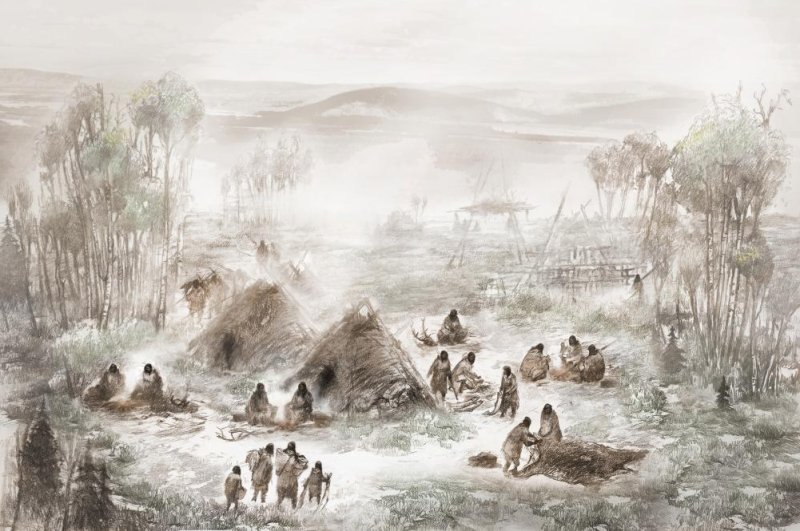An artistic rendering of the Sun River camp, home to a newly discovered population of Native Alaskans. Photo by Eric S. Carlson in collaboration with Ben A. Potter
Jan. 4 (UPI) -- New genetic analysis has revealed the presence of a unique Native American population living in what's now Alaska some 11,500 years ago. Researchers named the people "Ancient Beringians."
"We didn't know this population existed," Ben Potter, a professor of anthropology at the University of Alaska Fairbanks, said in a news release. "These data also provide the first direct evidence of the initial founding Native American population, which sheds new light on how these early populations were migrating and settling throughout North America."
The analysis was informed by DNA from the remains of a six-week-old infant discovered at the Upward Sun River archeological site in Interior Alaska.
Local Native Alaskans working with Potter and his team of excavators named the infant Xach'itee'aanenh T'eede Gaay, which translates to "sunrise girl-child." Scientists already had DNA from another infant found in 2013 -- named Yełkaanenh T'eede Gaay, "dawn twilight girl-child."
The DNA analysis suggests the two were closely related, likely cousins. They lived roughly 11,500 years ago. Scientists used the new DNA samples to inform ongoing genomic analysis. The genetic profile of the two infants failed to match those of other native groups.
"It would be difficult to overstate the importance of this newly revealed people to our understanding of how ancient populations came to inhabit the Americas," Potter said. "This new information will allow us a more accurate picture of Native American prehistory. It is markedly more complex than we thought."
Previously, studies suggest a founding group of Native Americans split from East Asian populations some 35,000 years ago. The latest research -- published this week in the journal Nature -- suggests a second split. Around 20,000 years ago, the founding group diverged to form two groups: the Ancient Beringians and the ancestors of all other Native Americans.
Scientists aren't sure whether the two native groups split before or after they crossed the Beringian land bridge, which disappeared some 15,700 years ago.
What is clear -- as evidenced by their distinct genetic profiles -- is that the Ancient Beringians remained isolated in the Far North as the second group moved south and spread out across North America.
Researchers believe the second group yielded Alaskan Athabascans, the indigenous group that still occupies Interior Alaska today. The ancestors of the Athabascans likely moved back north from the southern groups and absorbed or displaced the Ancient Beringians.
"There is very limited genetic information about modern Alaska Athabascan people," Potter said. "These findings create opportunities for Alaska Native people to gain new knowledge about their own connections to both the northern Native American and Ancient Beringian people."















